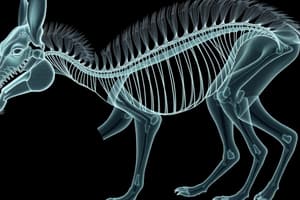Podcast
Questions and Answers
What type of infection is Athlete's foot?
What type of infection is Athlete's foot?
- Fungal (correct)
- Viral
- Bacterial
- Parasitic
Which substance is commonly used in a clinical thermometer?
Which substance is commonly used in a clinical thermometer?
- Mercury (correct)
- Alcohol
- Oil
- Water
In which part of the plant does the hypocotyl hook form during germination?
In which part of the plant does the hypocotyl hook form during germination?
- Rice seed
- Bean seed (correct)
- Maize seed
- Wheat seed
Which of the following organ systems is primarily involved in excretion?
Which of the following organ systems is primarily involved in excretion?
The largest volcano in the solar system, Olympus Mons, is located on which planet?
The largest volcano in the solar system, Olympus Mons, is located on which planet?
What is the primary charge of a proton?
What is the primary charge of a proton?
Which of the following materials is a non-luminous object?
Which of the following materials is a non-luminous object?
Where does the chemical digestion of proteins begin?
Where does the chemical digestion of proteins begin?
Flashcards are hidden until you start studying
Study Notes
Human Classification
- Human beings are classified as Omnivorous organisms, meaning they consume both plants and animals.
Clinical Thermometers
- Clinical thermometers primarily use Mercury as the liquid for measuring temperature due to its consistent expansion with heat.
Force Effects
- A force can change an object's size, direction, or mass, but it cannot change its speed.
Circuit Completion
- To complete an electric circuit, a Switch is required along with components like wires and batteries.
Athlete's Foot
- Athlete's foot is a fungal infection, not viral or bacterial.
Germination
- The hypocotyl hook is a structure formed during the germination of a bean seed.
Luminous and Non-Luminous Objects
- A non-luminous object is one that does not emit light; an example is glassware.
Volcanoes in the Solar System
- The largest volcano in the solar system, known as Olympus Mons, is located on Mars.
Plant Respiration
- During the night, plants release more Carbon dioxide.
Atomic Structure
- A proton is the only subatomic particle with a positive charge.
Solutions
- An example of a solution is sugar dissolved in water.
Speed of Sound
- The speed of sound in air is approximately 332 m/s.
Digestion of Proteins
- Chemical digestion of proteins begins in the oesophagus.
Pollen Structure
- Pollen grains are microscopic structures found in the anther of flowers.
Food Chain Initiation
- The food chain always starts with a producer, such as plants that produce energy through photosynthesis.
Atomic Numbers
- If an atom has an atomic number of 16 and a mass number of 32, it has 16 protons.
Changes in Matter
- The burning of wood is classified as a chemical change, altering the substance's composition.
Sound Measurement
- The decibel is the unit used to measure the amplitude of sound.
Reflector Telescope
- A reflector telescope utilizes mirrors to collect and focus light.
Brain Structure
- The forebrain is also referred to as the cerebrum, which is responsible for various higher functions.
Excretory Organs
- The main organ responsible for excretion in the body is the kidney.
Studying That Suits You
Use AI to generate personalized quizzes and flashcards to suit your learning preferences.




